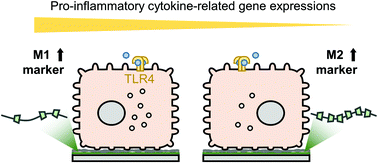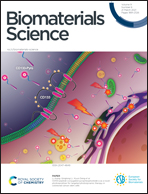Molecular mobility of polyrotaxane-based biointerfaces alters inflammatory responses and polarization in Kupffer cell lines
Abstract
A polyrotaxane is a supramolecular system composed of a linear polymer (e.g., poly(ethylene glycol): PEG) chain with bulky groups at both ends that threads through the cavities of multiple macrocyclic molecules (e.g., α-cyclodextrins: α-CD). Its structural properties allow for the threading α-CDs to move along the PEG chain, and the extent of mobility can be modulated by the number of threading α-CDs. In the present study, we prepared polyrotaxane-based surfaces with tunable mobilities, and evaluated the effect of molecular mobility on the activation of Kupffer cells. In particular, we analyzed the morphological changes and the gene expression of inflammatory cytokines in the presence of lipopolysaccharide (LPS), an immune-activator, using polyrotaxane-based surfaces with different molecular mobilities. Morphological changes were observed in the Kupffer cells depending on the number of threading α-CDs in the polyrotaxanes. This result suggests that the molecular mobility on the polyrotaxane surfaces acts as a mechanical cue for changing the morphology of Kupffer cells. Furthermore, the highly mobile surfaces with a small number of threading α-CDs promoted vacuolar formation in Kupffer cells and increased the gene expression of pro-inflammatory cytokines in the presence of LPS. These results suggest that polyrotaxane surfaces with tunable mobilities can be used as culture platforms for elucidating the mechanism by which mechanical cues contribute to the immune activity of Kupffer cells. Furthermore, by applying the molecular mobility of polyrotaxane to implantable scaffolds, it could be used as a tool for balancing the immune response in the living body.

- This article is part of the themed collection: Biomaterials Science Most Popular 2021


 Please wait while we load your content...
Please wait while we load your content...